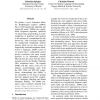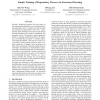7 search results - page 1 / 2 » Predicting Morphological Types of Chinese Bi-Character Words... |
LREC
2010
13 years 6 months ago
2010
This paper presented an overview of Chinese bi-character words' morphological types, and proposed a set of features for machine learning approaches to predict these types bas...
EMNLP
2008
13 years 6 months ago
2008
Chinese is a language that does not have morphological tense markers that provide explicit grammaticalization of the temporal location of situations (events or states). However, i...
EMNLP
2004
13 years 6 months ago
2004
The morphology of Semitic languages is unique in the sense that the major word-formation mechanism is an inherently non-concatenative process of interdigitation, whereby two morph...
COLING
2010
12 years 12 months ago
2010
We present a novel Evaluation Metric for Morphological Analysis (EMMA) that is both linguistically appealing and empirically sound. EMMA uses a graphbased assignment algorithm, op...
IJCAI
2007
13 years 6 months ago
2007
Recently, significant progress has been made on learning structured predictors via coordinated training algorithms such as conditional random fields and maximum margin Markov ne...


